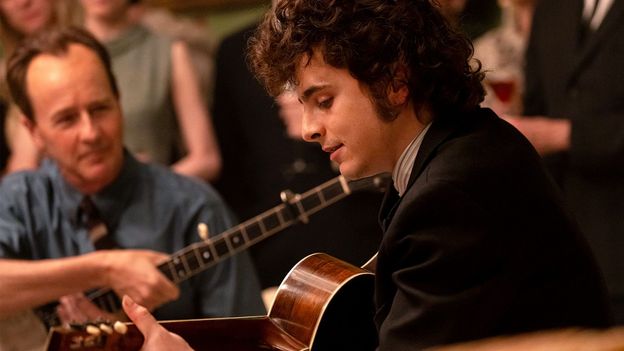 Macall Polay
Macall PolayDespite its “kinetic performances and irresistible music” from star Timothée Chalamet and cast, James Mangold’s Dylan biopic is disappointingly unambitious.
Bob Dylan is a master of self-mythologising. Decades ago he created his image as a brilliant enigma, which has made him an ideal canvas on which film-makers have projected their own interpretations. Todd Haynes’s I’m Not There (2007) created six fictional variations, Martin Scorsese playfully danced around Dylan in Rolling Thunder Revue (1975), a mock-documentary about his tour of the same name, and the Coen brothers created a musician resembling Dylan (loosely based on his contemporary Dave Van Ronk) in Inside Llewyn Davis (2013). All those films are more resonant and creative than the much-anticipated A Complete Unknown, in which Timothée Chalamet plays Dylan from his arrival in Greenwich Village in 1961, on to fame and then his culture-rattling turn from acoustic folk-inspired music to electric instruments in 1965. Director James Mangold has insisted that he was not making a biopic, but he has delivered just that: a likeable but disappointingly conventional film galvanised by its kinetic performances and irresistible music, and flattened by its safe, unimaginative script.
Dylan himself approved of the project, meeting with Mangold while he was writing the screenplay (based on a previous script by Jay Cocks). Dylan even posted about the film on X recently: “Timmy’s a brilliant actor so I’m sure he’s going to be completely believable as me. Or a younger me. Or some other me.” That’s the kind of pure Dylanesque statement, with his projection of a chameleonic persona, that A Complete Unknown misses.
Fortunately, it turns out that Timmy is brilliant here and completely believable, better than the film itself. He sings and plays guitar and harmonica with apparent ease, and creates a thoroughly convincing avatar of Dylan. At 19, he arrives in New York straight out of Minnesota, with a backpack and a guitar, and in this telling soon goes to visit his idol, Woody Guthrie, who is in a veterans’ hospital. (The hospital visit really happened. The film collapses timelines and events, but generally relies on facts.)
Singing the song he wrote for Guthrie, Chalamet looks out bashfully from under his eyelashes and channels the raspiness in Dylan’s voice. He suggests some uncertainty in the young Dylan but also the brash confidence of daring to perform for your idol. Scoot McNairy is heart wrenching and dynamic as Guthrie, who has lost the ability to speak but has a fire in his eyes. Edward Norton delivers a sly turn as Pete Seeger, who happens to be visiting at that moment and takes Dylan under his wing. As the film goes on, Norton is especially good at capturing the respect tinged with jealousy Dylan evokes in Seeger, benevolence turning to rigid disapproval when Dylan’s music begins to change. Like all the other supporting actors, Norton does his own singing, impressively. And the film does a swift, effective job of setting the musical landscape Dylan comes out of: the earnest, old-timey tradition embodied by Seeger’s banjo-playing version of Guthrie’s This Land is Your Land.
Mangold (who directed the Johnny Cash and June Carter biopic Walk the Line) is too smart to attempt to explain Dylan, so the film sees him from the outside in, through others’ eyes. That spares us any cringey scenes depicting the creative process. The songs arrive on screen almost fully formed, and Chalamet gets plenty of time to perform Blowin’ in the Wind and The Times They Are A-Changin’. But that approach also makes the film feel by-the-numbers and perfunctory, especially in its first hour as it walks through scenes from his early career. Focusing on a slice of life rather than taking a cradle-to-now approach doesn’t avoid the worn-out tropes of a biopic. They include a huge overload of hokey reaction shots as listeners look on in awe when the young Dylan performs at an open-mic night, and glimpses on black-and-white televisions of news about the Cuban Missile Crisis or Dylan singing at the March on Washington.
As Joan Baez, Monica Barbaro’s job is as difficult as Chalamet’s, in portraying a very familiar figure, and she pulls it off perfectly. She has Baez’s exceptional clarity of voice, and is a stirring presence as the Baez-Dylan relationship plays out, on stage in duets and in their on-and-off romance. Well-matched in talent and wilfulness, Baez is strong enough to call Dylan out on his posturing, and laughs at his claim that he travelled with a carnival and learned guitar chords from a cowboy named Wigglefoot. Chalamet and Barbaro give them great chemistry together. (A movie about that relationship is one I’d want to see.)
Elle Fanning has less to work with as Sylvie Russo, based on the real-life Suze Rotolo, who was Dylan’s girlfriend in those years, overlapping with Joan and others, as she was well aware. In two scenes, Sylvie’s eyes fill with tears as she realises she’s losing Bob to Joan. That is one teary scene too many, but Fanning’s performance is so natural she makes them work.
A Complete Unknown
Cast: Timothée Chalamet, Elle Fanning, Monica Barbaro, Edward Norton
When Sylvie complains that she knows nothing of Bob’s past, he yells “People make up their past, Sylvie! They remember what they want, they forget the rest”. That line is in the trailer, and there isn’t much more of that theme in the film itself, another way in which it lets down its own promise. Spinning his own myth, inventing a story in which he was a troubadour roaming the country picking up tips from blues musicians, is an essential part of Dylan, something an ambitious film would do more than hint at.
The film finally takes off in its later stages, after he becomes famous and resists being boxed in musically. His look changes, and he is the Dylan of wild hair, dark glasses and a sardonic tone. Trapped by fame, the character gets pricklier and much more interesting. We see him in the studio recording Like a Rolling Stone, adding electric guitars and a rock sound. The film recreates the famous performance at the 1965 Newport Folk Festival and the tumultuous response, when his electric versions of Maggie’s Farm and Like a Rolling Stone horrified folk purists, including Seeger.
Chalamet gives Dylan a defiant look in his eyes and through these later scenes creates a visceral sense of his restlessness, of how important it is for him to break free of the public assumptions about him, both musically and as the spokesman of a generation. You can finally feel an energy that can’t be restrained and that should have been in the film all along.
A Complete Unknown is released in cinemas on 25 December in the US, and 17 January 2025 in the UK






Leave a Reply